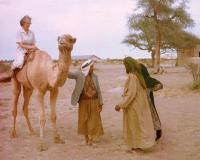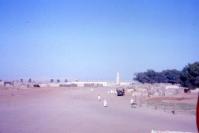Ramadan Memories
Susan notes: In 1962, nine years before the UAE was born, Canadian nurse the late Gertrude Dyck went to work in Al Ain’s first hospital. She lived in the UAE and Oman for more than 43 years, and is the author of “The Oasis, Al Ain Memoirs of ‘Doctora Latifa. This is what she told me about her memories of the Holy Month of Ramadan in the 1960s. Read more about Gertrude at these links: About Gertrude Dyck and Gertrude Dyck (Nurse/Missionary/Author).
 From the time I knew that this was where I was coming, there was a lot of planning and preparation. And the first trip to get here was a REAL adventure.
From the time I knew that this was where I was coming, there was a lot of planning and preparation. And the first trip to get here was a REAL adventure.
But before I tell you about all that, since it’s Ramadan now, maybe I should tell you a little bit about how this time of the year was for me in those early days... (Left: unidentified hospital staff person on a camel with local people)
When I first came to the UAE I knew nothing about Ramadan. But I soon learned – we all learned – from the patients coming to the hospital, what it was all about.
Day Becomes Night
Patients would only take their medication at night; they wouldn’t even take an injection during the day, because during Ramadan all Muslims must fast from dawn to dusk. We could tell by their breath if they were fasting. It was a very distinct odour, like diabetics when they are off course. Speaking of diabetics, they had to regulate their insulin and meals for the nighttime for this one month.
 There weren’t as many diabetics here then as there are now.
There weren’t as many diabetics here then as there are now.
As I recall, we only had one death from diabetes in those early days, maybe because people were more active and working a lot in their homes – life then was a lot more difficult than it is now.
Even that one death made us think that we should do more testing. We did what we could.
Anyway, during Ramadan, everyone was always in a hurry to get home to get extra sleep, because most of them were awake all night and also they had to cook for the iftar. Some would sleep between midnight and 4 a.m., especially the nursing mothers, and people who were sick. (Above: main street Al Ain, UAE circa 1963)
Everything switched around, and day became night; it was strange for us at first. We didn’t see people as much during the day as we did normally, and we didn’t go to see them unless it was for a medical reason – if someone was really sick.
The people we did see in the day were mostly men who were working outside and who came to us suffering from heat strokes or dehydration, and heat exhaustion. They still had to go work in the daytime then, there was no such thing as night shifts, and it was hard for them to work long hours in the heat without food or water.
Different Ways
The days were hard, but the nights were wonderful. That was the time to see people, just like it is now. We loved visiting until quite late at night, even though we still had to get up early, because we had clinics in the morning, and we were on call in the afternoons and evenings as well.
When you are a nurse or a doctor in a remote area, you’re on call all the time – 24/7 as the saying goes today! Later we changed to evening clinics during Ramadan, because we found it was better for the people, as well as for us.
Everyone we visited always had lots of food, nice rich food, their favourite local dishes. There was always a barbecued goat or lamb – the whole animal, it wasn’t cut up ahead of time – and roasted chicken. The meat usually sat on a bed of thin bread.
Even though I had grown up in a farming community in Canada, I had never seen a whole animal served like this before. Of course I had seen butchered cattle, sheep and other animals. As I told you, we used to have them hanging outside in the winter to keep them frozen – that’s where our food supply came from during the cold winter months. And sometimes we cooked a whole animal on a spit for a large group of people, but it was always cut up in slices or pieces and served to people on plates.
Special Foods and Traditions
Usually there were other special foods like “harees,” which is cracked wheat mixed with soft meat from a very young animal, and “belaleet,” a vermicelli dish with fried onions, sugar and a nice big omelette on top, and the very thin bread they baked on the open fire, with meat sauce or butter and egg on it.
And a favourite speciality was the “cumfroosh,” a deep fried little fritter served with honey on it. Of course there were always dates, if in season, the fresh ones, otherwise the nice soft dried ones, and fresh fruits like sweet oranges, and "hamba" a local variety of mango, and small bananas from Oman; there weren’t any imported fruits in the sixties.
All the food was placed on a huge straw mat on the floor or the ground, and all of us would sit around this mat, in shifts. It was a real feast I tell you!
I later learned that we could join some of them for the iftar – the breaking of the fast in the early evening. Iftar was usually more of a family time, but it seemed we could go to those who had bigger groups of people coming to them.
Another tradition was for the families to send their children or servants to the homes of the “shyuukh” (the plural form of sheikh; pronounced she-oo-kh), at sunset to get food that they would then bring back to the families’ homes. The shyuukh were happy to give them food, as that was part of their “zakaat” (giving of alms) during Ramadan.
The Ramadan food tasted different to anything I had experienced before, and the way of eating it was a new experience, as were the local traditions. But I grew to like it all quickly, and I loved the sense of community and family and the feeling of goodwill and sharing that is especially a part of this time of year.
Ramadan in those early days reminded me of Christmas and Easter in Canada, except this celebration was much longer!
Related links:
Gertrude's story